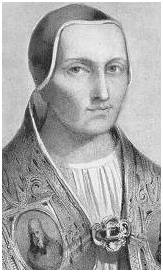BÉZIERS HISTORY
Various names through the time : Besara/Bessara (from Avienus' written), Betarratis (on the Volques coins), Baeterrae/Baetirae (at least 35 BC, from Pline), Beterris at least IX-th century --> XV-th, then Besièrs or Béziers (XVII-th)
Béziers has a very antique history, doubtless more than any other city of the Occidental coast of the Mediterranean Sea. The Béziers area hills, as well as those where the city took place, were formed at the Ice Age. Already, traces give evidence of human presence : carved flints techniques specific of the Chellean Age, first stage of Paleolithic or Stone age. At this time, the glaciers occupied regularly valleys, digging or filling them; it was the same for the sea impacting or withdrawing the Béziers' hills.
Today it is yet possible to find fossil shells on the "Four à Chaud" hill, close to the Fontneuve quarter (down the old cemetery) and close to the village of Cessenon in the ancient marble quarry. The climate looked sometimes like the Alaska Tundra or in other time like the warm plains of Africa. Animals living there were rhinoceros, hippopotamus, mammoth, bison or reindeer and mouflon.
The most ancient human presence traces are lanceolated bifaces from the Riss gelidity' time. In 2002 during the Republic street's roadworks were found raw bricks made of clay and an oven dated 5000 BC. Those discoveries - and many others - have proved presence of "advanced" sedentary tribes. The other traces consist in huts' foundations of the Véraziens' tribes (2500 BC). Structured urbanization (houses along streets) dates from the 2nd Iron age : It is from a people named "Elysices" (certainly Celtiberes).
The Volcaes (tribe of the Cimbres nation - the same ethnic group as the Gauls) settles down in the middle of 3rd century BC from Toulouse to the Rhone. Then from Toulouse to the Hérault river, they were tribes Tectosages then Arecomicis. In Béziers, they were (maybe) the Longostaletes (this people is mentioned on currencies at this time). The Volcaes were certainly the "customers" of the Arvennes.
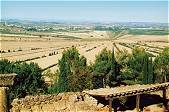
En 600 BC, construction of the Ensérune's oppidum.
The Chaldean Beross, who lived 350 years BC, tells us that Heracles - travelling through the Celtic Gaul - had children with Galathée, daughter of a region native noble man. Afterward these Heracles's sons decided to build many cities and gave them their names.
A ford, indeed, existed up to the XIIth century down the walls of the city; it is possible that Béziers's primitive nucleus was formed on the Orb's river shores, to become, later , on the nearby height, an Oppidum where the Gauls took refuge in times of war. However, "Biterri" could result from an ancient Basque word "Village of the road". In the IVth century BC, Béziers becomes one of the main cities of the Volcaes Tectosages, miscellany of Celtic, Iberians, Ligures (coming from east side of Rhone), Phoceens and Rhodeens - which had based their counters and colonies there. They bring on our coasts the vineyard's culture, the olive tree and overall the seeds of civilization.(view the map)
En 600/500 BC, foundation by the Greeks of the first city. The archeological excavations performed in the Republic street and in the Madeleine place show existence of a Greek city, 40 hectares large, with lead canalizations, cereal reservoirs (pithos) and 150 meters square superb villas.
En 121/118 BC, construction of the Via Domitia (Domitian way), named by Aristotle 'Via Herculanum' or Heracles way before its Roman use) by the Neron's father, Cneius Domitius 'Ahenobarbus' (that means 'with beard of brass'), first Roman road in Gaul.
Gaullic city of the Volcaes, Béziers, named at this time Beteris, becomes the Julia Baetarrae's Roman colony in 36 BC and is included in the Narbonnaise's province. The forum took certainly place in front of the actual city hall. First main stage on the Domitian way, the city is an active trade center. The wine, first imported from Campanie is exported to Rome in the 1st century, following the vineyard introduction in the Biterrois' plains. But in 77, following a viticultural crisis (already !), a decree (decree #92) is pronounced to promote the vineyard uprooting in Gaul. This decree will be abrogated in 280 by Protus who restores the right to plant vines. In the 3rd century, the city is surrounded with remparts.
In 450, Béziers is conquered by Visigoths, who keep it until 712-724 (see the map of France at this time), date from it is conquered by Saracenic. Those ones destroy massively all vineyards. In 736/737, the city is finaly taken again but immediately devastated by the Francs, conducted by Charles Martel (Pépin de Herstal and Aldaïde Pépin's bastard son, and future Charlemagne's grandfather, whose nickname Martel has been added later after his death to make difference between the others Charles of his dynasty).
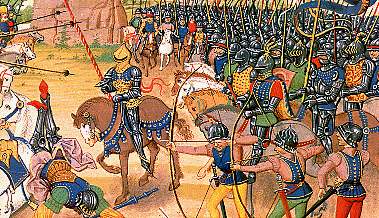
The power is shared between the viscount, the bishop and, from 1131, the consulate, institution created by a communal charter given to the city.
On october 15th 1167 : Raimon Trencavel's assassination :
The last august, the viscount came to help his nephew, Bernard Aton, Nîmes and Agde's viscount, who was prisoner of the king of Aragon. A Trencavel's soldier "borrowed" a nobleman's horse to make it carry his luggage.
As the nobleman asked for justice, Trencavel was obliged to impose sanction to the soldier (the sentence was light because all the troops threatened to desert...).
On october the 15th, following the event and as Trencavel stayed in the Madeleine church, he was took by the Béziers's bourgeois and lynched to death. the bishop Bernard, who tried to intervene, got his jaw broken.
The Pope - who learnt about this horrible slaughter - excommunicated the whole city.
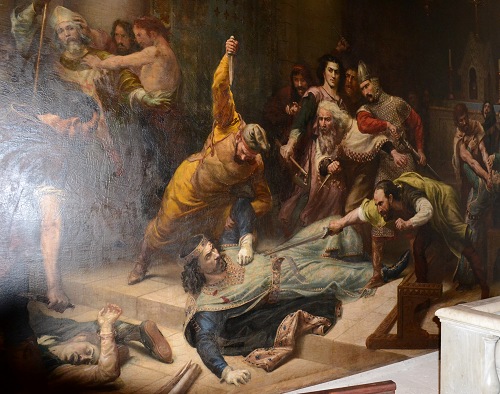
Trencavel's assassination
in the church of Madeleine
In 1185, in the St Nazaire church, are proclaimed numerous decrees : "La charte libérale" :
- Now, the Viscount is allowed to create new taxes without any people agreement (was it the beginning of the modern world : )) ?).
- The Bishop and the Viscount can't - one without the other one - ask for a citizen's vow.
- The testimony of the Viscount and Bishop's bailes (prosecutors) cannot - alone - certify an adultery act; they must get neighbors and notables's testimonies who were there when the guilties were "arrested".
- A foreigner who promises and swears to stay in Béziers at least for one year will be exonerated of all local taxes (sorry that doesn't work anymore :D ).
- Possessions of those who dies without will or without known heir are kept for one year and one day. Then they will own to the City lord (Viscount, Bishop or Clergyman).
- The persons called to be presented to judge will not have anymore to pay a guarantee.
At the beginning 1200, supported by the pope Innocent III, Simon de Montfort gathers an important army, during the crusade against the Catharis :
The crusade steps forward Toulouse in three enormous masses. The meet is planned in front of Béziers. The great north army, led by Arnauld Alméric - Citeaux's abbe - is made of out-of-Loire's people and princes. They are known and named as the "Français" (François - The French).
The west army, less numerous, is made with d'Aquitains, led by the Bordeaux's archbishop.
The third army, less numerous too, is led by the Puy-en-Velay's bishop and comes from Cantal. The immense crusade, tumultuous and abashed, made of around 300 000 fighters, arrives on july 22th 1209, the day before Saintly Madeleine celebrations, in front of the city's ramparts. Along the road, it has increased with all the European vagabonds and brigands as the king of ribauds, at the head of 15 000 rag clothed gangsters, looking like an hideous vanguard.
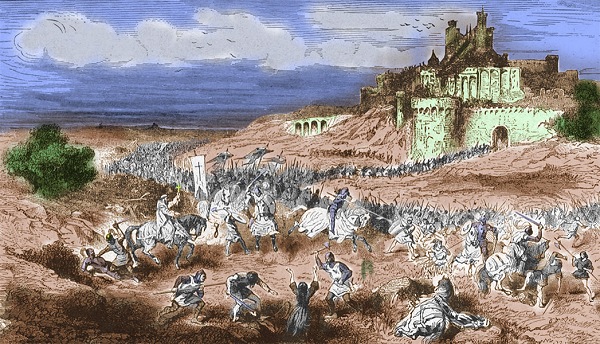
the crusaders and the onslaught of Béziers, by Paul Lehugeur, XIX-th
It surrounds the city as a thick cloud and camps close to the ramparts. Hundred of tents are installed all around the city, some decorated with luxurious wings and flags. Renaud de Montpeyroux, the city's bishop, goes out to try to negociate with the assailants. But Amaury gives him the ultimat to send 222 Catharis or Vaudois heretics whose names were written on a list (written by the bishop himself) or to leave the city and abandon there all the heretics. The bishop and some Catholics leaves but many priests prefer to stay inside the city with their parishioners.
A few Biterrois deliberates all night long and decides to attack first in the early morning. As the first day's lights appear, they leave through the eastern door, shaking their white pénoncels (banners) and screaming as to terrify birds. They begin to shoot some arrows. A crusader - who ventures to stay on the front door bridge (Carmes/St Guilhem ?) falls dead transfixed. A mobster is captured, throws over down the bridge and shreded.
|
|
With this unexpected attack and the seeing of the victim the king of the ribauds rings the horn : the tone awakes the whole camp as a frightened swarm. The marauders wake up, full of rage, shirt or rag clothed, without shoes and armed with pike, lever, mace, ... The scream "aux armes !" sounds in the princes' camp; the knights run to the nomads' rescue. The hideous horde repulses the militia to the walls then enters through the deep arch of the eastern door and finally takes place in the city. For two hours fights go on close to the door and in the north neighborhood. But the ribauds' human tide, followed by the crusaders army, invades the battlements and - gradually - the whole city.
The citizens move back; the fight becomes stampede and stampede becomes slaughter. The 15 000 mobsters from the ribauds' army rush through the town without any Crusaders military chiefs' orders. Murder is everywhere, street to street, house to house, district to district. The ribauds cut the throat of anyone, women, chilfren, old men and even priests. Around seven thousands citizens, who took refuge in the Madeleine's basilica, have their throat cut. Others, in the Saint Nazaire's cathedral, get the same destiny. Some priests - who wanted to celebrate a mass to the death - are killed on the altar. The two churches are put in fire to "finish" the last survivors. Then, after murder, takes place the looting and the looting gives fight between victors.
The barons try to tear the town off the brigands' rapacity. They hit them with swords or batons to make them let their spoil. But the Gypsies' king doesn't want to let his spoil in the Citeaux's abbot hands : it was the price for the butchery. He orders tu burn the whole city, full of affluence, full of cadavers. The fire pulls out the victors, eats their prey and their hopes and the whole Béziers is dying. The number of the slain : The Citeaux's abbot admits 15 000 to the pope Innocent III : 7,000 in the Madeleine and 8,000 in Saint Nazaire. Nangis adds 2,000 more and Guillaume le Breton gives the number of 60,000. Some others authors will claim 100,000; however 50 to 60,000 killed must be a number more close to the truth.
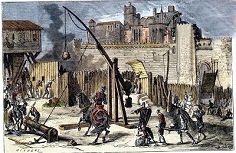
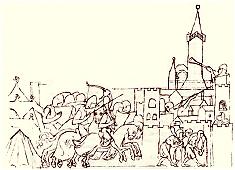
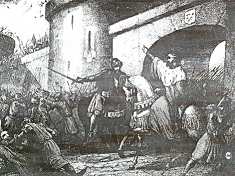
The Saint-Nazaire's cathedral, built at the end of the XIIth century, by a man named Maître Gervais, is burnt and collapses on people who came there to be protected.[From this time building remains now the two right spans of the heart, the bell tower base and the transept's lower parts. Following this destruction, the cathedral will be progressively rebuilt : the nave repairing (XIIIth century end) then rebuilt of the heart, side chapels, eastern facade and cloister (XIVth century). Then, in 1444, the bishop Guillaume de Montjoie will create the saints Nazaire et Celse's devoted chapel (curent sacristy) as the one located up the capitulary room. Between 1623 and 1632, a tribune and an organ will take place to the bitter end of the nave. In the XVIIIth century, the heart is restored and the jube - who closed it at the transept level - is destroyed. The cathedral will be restored in the XIXth century, then in en 1932.]
This slaughter (the "gran mazel" in Occitan - the big butchery) will stay for a while in the minds. Béziers will be burnt during 3 days by the crusaders. A large heap of ruins will stay on the hill for a century, a dark heap of rubble and stones. It will be a privileged subject for the troubadours as the famous Toulousain Guilhem Figueira who wrote a virulent diatribe against the Roman Church.
In 1229, Béziers is attached to the French kingdom.
In 1562, the reformed people take the city and wreck the Catholic buildings. Once the order is back, the city becomes one of the Dukes of Montmorency's home.
In 1632, following the Henri II de Montmorency's revolt failure, it's in Béziers that the king, the queen, Richelieu and his council promulgate the edict which removes the franchises of the Languedoc.
Under Louis XIV's reign, the city becomes wealthy. The local bourgeoisie lives with the incomes of their properties where are produced corn, wine and olive oil. Along the Bagnols' stream shores, we can find mills, distilleries and tanneries. The weekly market certificated with a royal decree in 1552, is a place of trades along the road between the vallée du Rhône and Spain. Béziers is the Marquis Pierre Paul de Riquet's homeland, the builder of the canal du midi. The construction will take 14 years from 1666 to 1680.
The traditionalist and Catholic city, where thrives a cultivated bourgeoisie, doesn't care about revolutionists ideas. However its bishopric - founded in the IVth century - is removed in 1801.
The economic prosperity becomes stronger in the XIXth century : the agricultural properties are enlarged and modernized, and - with the railroad development (railroad Bordeaux-Sète, 1857) - the Biterrois begins the vineyard's monoculture. Not very contaminated by the phylloxera, who hits the vineyard in 1878, Béziers is the wealthiest city of the Languedoc at the end of the XIXth century. However it can't excape from the viticultural crisis - fall of the sales - in 1907.
The viniculture's development induces progresses in many new industries (cooperage, concrete tanks, fertilizers, agricultural material), to the détriment of traditional activities (textile industries). Otherwise, the town gets financial institutions, trading and transport's societies but too an alimentation stores' network as the "Ruche du Midi" or the "Docks méridionaux" (42 stores in 1911).
The Béziers' enrichment gives a considerable population's increase : the citizens' number nearly quadruples between 1821 and 1901.

